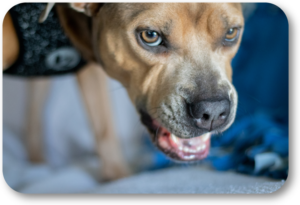A friend of ours from Alpharetta contacted us last week because of an ongoing issue with his eighteen-month-old Bull Terrier named Pappy. The first thing he told us that for 99.99% of the time, Pappy is the most perfect dog they have ever owned. Pappy’s biggest issue was that many times he would “get weird” with his food. He told us that Pappy would be very protective of his food. Sometimes he would even become aggressive.

Even though these inappropriate actions did not happen very often, he was afraid that it could take place with a family member or friend. Things could quickly go from OK to really bad. He asked for any suggestions we could offer to help him understand how to deal with this and assure his family’s safety.
We initially explained that any sort of aggression in a dog is never a good thing. The good news lies in the fact that canine food aggression can be minimized, redirected, or often entirely resolved. The first thing we told our friend was that he needs to understand what may be causing Pappy’s possessive nature with his food. That will help us eliminate the possibility of aggression.
Robin and I had forgotten how Pappy came to be a part of his family. So, the first thing we asked was if Pappy came to the family as a stray or rescue dog. Our experience has shown that dogs that have been strays or rescues often display possessive and sometimes aggressive tendencies when it comes to their food. He told us that Pappy was a rescue.
Even though Pappy is now safe and is given all the resources necessary to stay healthy and happy, his prior experience as a stray or rescue has often shown that food is a limited resource. Lack or loss of food becomes a very large safety and health issue with these dogs. When these dogs obtain food, it becomes essential to safeguard this limited commodity. If Pappy had his food withheld, that could also be a reason for his aggressive and/or possessive stance towards food.
We needed to come up with a plan to help our friend with Pappy’s food aggression issues. Although this is not a “quick fix”, there are several action items he can immediately implement. Let’s discuss some of them now:
- Our friend needs to figure out where he wants to feed Pappy and the times he wants to feed him. If Pappy has the ability to decide when and where he wants to eat, he will not see our friend as the owner and provider of the food. It is important that Pappy understands that his food supply is always safe and being provided by his trusted care giver and strong leader. This means that when it comes to food, nutrition, and his health, (in the words of Forrest Gump) he has “one less thing to worry about”.
- Robin and I suggested that he start the process of scatter-feeding with Pappy. This is where our friend takes Pappy’s food and scatters it on the ground or in the yard. Pappy will now be “grazing” across a large area. This means that he will not be “protecting an exact spot”. We also told our friend to hide some food behind a chair or under a plant. This will have Pappy focused on “the hunt” and not other people coming and going in the area.
- It is crucial that our friend teaches Pappy some simple obedience commands that would include “leave it”, “stay”, and “wait”. He should review these commands during Pappy’s feeding times or when giving him a little treat. The obedience command will direct Pappy’s focus to him as the one giving him the food. It will also program Pappy to wait until our friend decides to feed him.
- If he needs to get Pappy away from his food, he should not approach him and his food bowl directly. As we always teach our dog training clients; this is an instinctual, aggressive act and not a good idea when working with a food aggressive dog. If he needs to get Pappy away from his food, we suggested that he use the Come command to have Pappy move to him. This will assure that he is “the boss in the room” and Pappy is giving him focus and responding to his direction. In Pappy’s eyes, the food is not as important as the safety provided by obeying our friend.
- We also suggested that he consider clicking a leash on Pappy during feeding time. This will help him redirect Pappy away from the food without becoming physical.
- Never feed Pappy in a corner. This limits his “fight or flight” options if anyone mistakenly approaches him. It may also amplify any aggressive or protective tendencies Pappy may still have over food.
We told our friend to keep the entire process really slow. Dog food aggression is a very difficult but resolvable issue. Time and patience are key. He needs to provide a continually safe and secure environment for Pappy during feeding time. This will reinforce the fact that “all is fine”.
As we said before, Pappy came from a situation where “eating was dangerous”. It will take some time to reverse this previously “learned notion”. The good news is that time and patience will always prevail in situations like this. My friend now had a plan and was ready to work with Pappy.
Please call or text us at (770) 718-7704 if you need any dog training help. You can also email us at [email protected]. We are blessed to have been your local dog training experts for over eighteen years. We have trained over 6,000 wonderful dogs and excellent families and are ready to help you.

Follow Us!